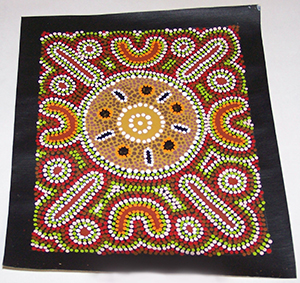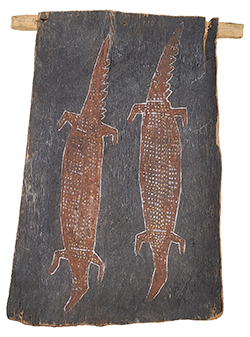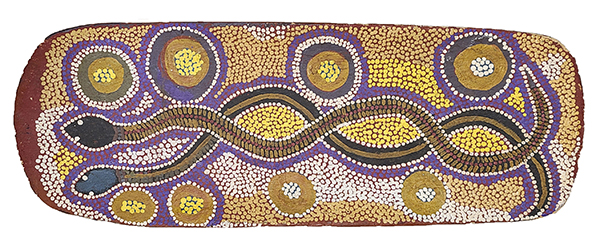Australia: Create a Dot Painting
Aboriginal people are the indigenous people of Australia. Aboriginal people are divided into about 400 hundred different groups, each with different languages, traditions, music, and arts. These groups have the oldest continuous cultures on the planet.
Click here to learn more about the Aboriginal people in a previous Cultures Up Close post.
Aboriginal Art

The Lam Museum collection includes this Aboriginal dot painting by Mingi May Barnes.
In the Northern Territory, cave art made by Aboriginal people is thought to be about 60,000 years old, making it the oldest art in the world. Today, authentic Aboriginal art can only be created by an Aboriginal artist. If a non-Indigenous Australian creates art using Aboriginal symbols and techniques, it is not considered Aboriginal art. Fake Aboriginal art is a huge problem. Click here to see a feature from 60 Minutes Australia about a fake Aboriginal art scam.
Dot Painting

This Aboriginal dot painting by Mingi May Barnes is also in the Lam Museum collection.
Dot painting is one of the most recognized forms of Aboriginal art. People think it is just simple dots, animals, and fine lines but it is much more than that. Aboriginal artists use symbols, images, and meticulous rules to create dot paintings that tell stories. If a story has historical or sacred information, an artist needs permission before they can paint it. Dot paintings are the visual stories of the Aboriginal people.
Historically, Aboriginal people of central and western Australia created “paintings” on the sand using rocks, flowers, sticks, seeds, and feathers. These paintings were full of sacred symbols, images, and meaning. As elders created the sand paintings, they sang songs and told stories about Aboriginal history, religion, traditions, and beliefs. Sand paintings were temporary, but eventually they became modern day dot paintings.

This Aboriginal bark painting from the Lam Museum collection is unusual because of its black background.
A more permanent form of sand painting was creating the work on tree bark. Painting on bark was first done on shelters, but in the 1920s Aboriginal artists were encouraged to recreate the paintings from shelters on small pieces of tree bark that could be sold to tourists and collectors. Click here to see Aboriginal artist Banduk Marika talk about her bark painting.
In the 1970s, European artists helped Aboriginal artists turn the sacred symbols and images from sand paintings into dots which could be painted on canvas, canvas board or sheeting. After that, works could be sold and shipped all over the world. Today, dot paintings appear on Aboriginal instruments, everyday objects, buildings, vehicles, and all types of tourist objects.

This coolamon (shallow wooden vessel) from the Lam Museum education collection is decorated with dot painting.
Whether dot paintings are created on tree bark, canvas, or objects they all share common elements. Dot paintings tell a story, the symbols and images have meaning, there is a connection between the artist and the work, and to be authentic they are created by an Aboriginal artist. Click here to see Aboriginal artist Nellie Marks Nakamarra create a dot painting.
Let’s Create a Dot Painting!
To get an idea what you’d like to create, you can search for more Aboriginal Dot paintings online. Then using the animal and symbols sheets we’ve provided, have fun creating your own dot painting!
Here’s what you’ll need:
• Animal templates (Download here)
• Aboriginal symbol’s sheets (Download here)
• Canvas board, canvas sheets or wooden board
• Newspaper or plastic
• Craft paints
• Paintbrushes
• Q-tips
• Water container
• Paper towels
• Paper
• Pencil
• Scissors
